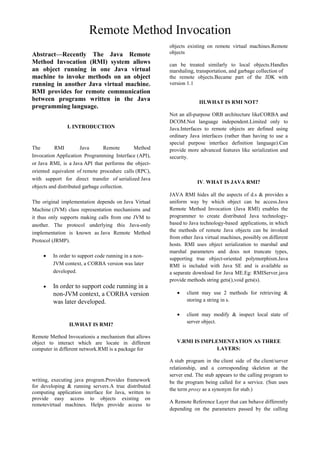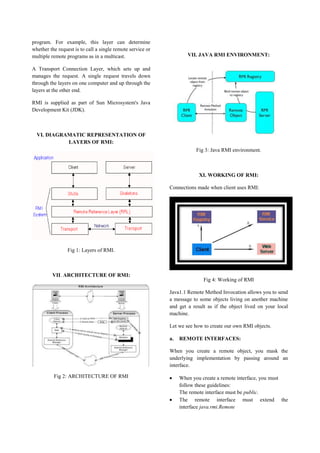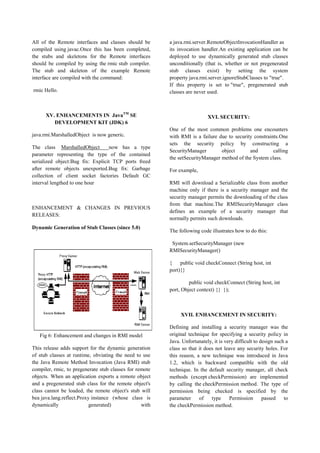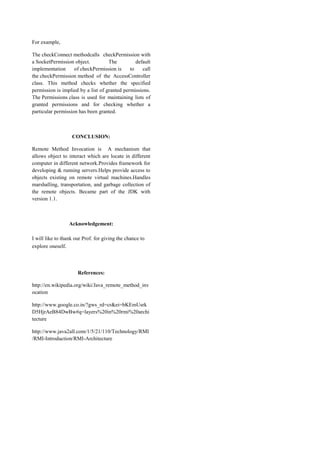Remote Method Invocation (RMI) allows objects running in one Java virtual machine to invoke methods on objects running in another Java virtual machine. RMI uses object serialization to marshal and unmarshal parameters and supports true object-oriented polymorphism. RMI is implemented using three layers - stub, remote reference, and transport connection layers. The stub and skeleton hide the underlying network implementation details and allow remote objects to be called similar to local objects. Security is an important consideration in RMI and a security manager must be installed and permissions configured to control access to remote objects and classes.



![X. PROGRAMMING A CLIENT:
Having described how to define Remote and
Serializable classes, we now discuss how to program
the Client and Server.The Client itself is just a Java
program.The name of a remote object includes the
following information:
The Internet name (or address) of the machine
that is running the Object Registry with which
the remote object is being registered. If the
Object Registry is running on the same
machine as the one that is making the request,
then the name of the machine can be omitted.
The port to which the Object Registry is
listening. If the Object Registry is listening to
the default port, 1099, then this does not have
to be included in the name.
The local name of the remote object within the
Object Registry.
The Naming.lookup method obtains an object handle
from
the
Object
Registry
running
on ortles.ccs.neu.edu and listening to the default
port.The remote method invocation in the example
Client is hello.say(). It returns a String which is then
printed
XI. PROGRAMMING A SERVER:
The Server itself is just a Java program.
Here is the example Server:
/*** Server program for the "Hello, world!" example.
* @param argv The command line arguments which
are ignored. */
public static void main (String[] argv)
{
Here is the example Client program:
try
/**
* Client program for the "Hello, world!"
example.
{
* @param argv The command line arguments which
are ignored.
Naming.rebind
("Hello",
new
Hello
("Hello,
world!"));
System.out.println ("Hello
Server is ready.");
*/
public static void main (String[] argv)
}
{
catch (Exception e)
try
{
{
HelloInterface hello =
(HelloInterface) Naming.lookup
("//ortles.ccs.neu.edu/Hello");
System.out.println ("Hello
Server failed: " + e);
System.out.println (hello.say());
}
}
catch (Exception e)
{
System.out.println
exception: " + e);
}
}
}
("HelloClient
The rmiregistry Object Registry only accepts requests
to bind and unbind objects running on the same
machine, so it is never necessary to specify the name
of the machine when one is registering an object.The
code for the Server can be placed in any convenient
class. In the example Server, it was placed in a
class HelloServer that contains only the program
above.](https://image.slidesharecdn.com/javaremotemethodinvocation-140306082141-phpapp02/85/Remote-Method-Invocation-4-320.jpg)



